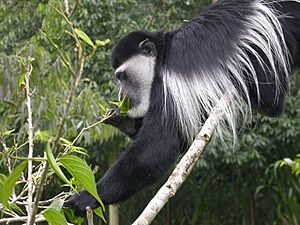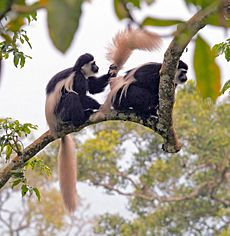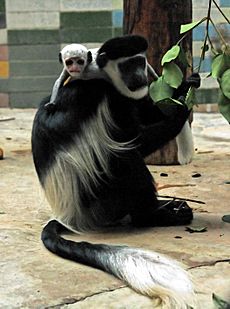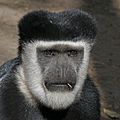Eastern black-and-white colobus facts for kids
Quick facts for kids Mantled guereza |
|
|---|---|
 |
|
| Mantled guereza at the Henry Doorly Zoo | |
| Conservation status | |
| Scientific classification | |
| Binomial name | |
| Colobus guereza |
|
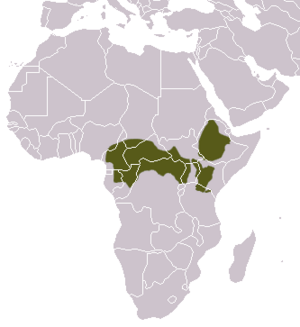 |
|
| Mantled guereza range |
The mantled guereza (scientific name: Colobus guereza) is a type of monkey that lives in Africa. It's also known as the eastern black-and-white colobus monkey. These monkeys can grow to be over 2 ft (0.61 m) long, not counting their tail. They can weigh up to 30 lb (14 kg). In the wild, mantled guerezas usually live for about 20 years.
Mantled guerezas are vegetarian. This means they only eat plants. They have a special three-chambered stomach. This helps them digest tough leaves, which are a big part of their diet.
Contents
What does a Mantled Guereza look like?
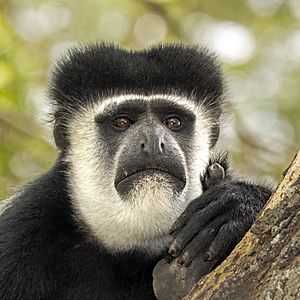
The mantled guereza has very unique fur, called a pelage. Most of its body is black. But it has long, white, silky hair along its sides and tail. This white hair looks like a cape or a "mantle." The mantle starts at their shoulders and goes down their back.
Their tail is long and has a white tuft at the end. The size of this white tuft can be different depending on the specific type (subspecies) of guereza. For example, some have a white tuft that covers half their tail. Others have a tuft that covers 80% of their tail! The mantle itself can be white, cream, or yellow. Their face is framed by white hair, and they have fluffy cheek hairs. They also have a white stripe on their thigh.
When baby guerezas are born, they have pink skin and white hair. As they get older, their skin and hair get darker. By three to four months old, they look just like the adults. Male guerezas usually get their adult colors faster than females.
Adult males typically weigh between 9.3 and 13.5 kilograms (21 and 30 lb). Females are a bit smaller, weighing between 7.8 and 9.2 kilograms (17 and 20 lb). Males are also a bit longer, averaging 61.5 centimetres (24.2 in) from head to body. Females average 57.6 centimetres (22.7 in). Like most colobus monkeys, the mantled guereza has a very small thumb. It's so small it's almost gone, which is called vestigial.
Where do Mantled Guerezas live?
The mantled guereza lives across Equatorial Africa. You can find them from Nigeria and Cameroon in the west. Their range extends to Ethiopia, Kenya, Uganda, and northern Tanzania in the east.
These monkeys live in many types of forests. They can be found in forests where trees lose their leaves (deciduous) and where trees stay green all year (evergreen). They often live in forest and savannah woodlands. They also like highland and montane forests, which are forests found in mountains.
Mantled guerezas are common near rivers and lakes. They can live at very high elevations, up to 3,300 metres (10,800 ft) above sea level. They often prefer forests that have grown back after being cut down (secondary forests). This is because these forests often have more of the trees they like to eat. The plants in these forests also have weaker chemical defenses, making them easier to digest. Sometimes, you might even find them in swamps. They can also live in places changed by humans, like Eucalyptus tree farms. They might visit these farms if they need certain nutrients.
How do Mantled Guerezas live?
Daily Life of the Mantled Guereza
Mantled guerezas spend most of their time in trees. This is called being arboreal. But they do come down to the ground sometimes to find food or travel. They are diurnal, meaning they are active during the day. They rest for up to half of the day. After resting, they spend most of their time looking for food or moving around.
Around dawn, mantled guereza groups leave their sleeping trees. They return to these trees at dusk to sleep. During the day, they have long rest periods. These breaks are in between times of moving and eating. They also spend some time grooming each other, greeting, playing, and watching for danger.
What do Mantled Guerezas eat?
Even though they are known for eating leaves, mantled guerezas eat many different things. Their main foods are leaves and fruit. But they might also eat bark, wood, seeds, flowers, and even insects. Sometimes they eat soil or aquatic plants. What they eat depends on where they live and the time of year. They choose their food based on how much protein, tannins, and sodium the leaves have. They might even travel far to find plants with better nutrition.
Leaves usually make up more than half of their diet. But sometimes, during certain seasons, they eat more fruit. When they eat leaves, they prefer young ones over older ones. For fruits, they like to eat them when they are unripe. This might help them avoid competing with other monkeys that prefer ripe fruits. They eat many different plant species. But at any one place, only a few types of plants make up most of their diet.
Like all colobus monkeys, the mantled guereza has a special stomach. It's large and has multiple parts. This helps them digest leaves and other plant fibers. Their stomach contains special bacteria that help break down the tough plant material. They prefer foods with a lot of fiber that their stomach can easily process.
Who preys on Mantled Guerezas?
The main predator of the mantled guereza is the crowned hawk-eagle. Other birds of prey, like Verreaux's eagle, also hunt them. Common chimpanzees are known to hunt guerezas. The leopard is another animal that might hunt them.
How do Mantled Guerezas behave?
Living in Groups
Mantled guerezas live in stable social groups. These groups usually have three to fifteen members. A typical group has one male, several females, and their young. In some places, groups with several males are common. In these multi-male groups, the males might be aggressive with each other. One male is usually dominant. Some males might even be forced to leave these groups. Multi-male groups can have father-son pairs or males that are not related.
Males that are not part of a group might live alone. Or they might live with other males in "bachelor groups." The females usually keep the group together. They are often related through their mothers (this is called matrilineally related). Females rarely leave the group they were born into. Males, however, usually leave when they become older teenagers or adults. They might live alone or join a bachelor group. They can join a social group by staying on the edge of it or by taking over from a male already in the group.
Because their diet is mostly leaves, which are spread out in the forest, mantled guerezas have a relaxed social structure. Females in a group often have an egalitarian dominance style. This means there are no strict ranks among them. Their relationships are usually friendly. They rarely show signs of who is in charge or who is not. Physical fights within the group are usually not serious.
Allogrooming, or social grooming, is very important for mantled guereza interactions. Females mostly groom each other. Adult males rarely groom in the groups. While not strictly territorial, mantled guereza groups can be aggressive towards each other. In some areas, groups might defend their main living areas, food, and mates. When groups meet, males might try to protect their mates or their group's resources. Males are usually the ones who get involved in fights between groups. But females might also join in. Aggressive meetings between groups usually involve chasing, showing off, and loud calls. They rarely involve physical fighting.
Having Babies and Raising Young
Mantled guerezas have a mating system where one male mates with several females. This is called polygynous and forms a harem. Both males and females will try to get a partner to mate. To do this, a guereza might walk near another and make soft mouth clicks or smacks. During mating, the male holds onto the female's ankles and body. Most mating happens between monkeys in the same group. But sometimes, mating outside the group has been seen. In groups with many males, more than one male might mate with the females.
A female guereza is pregnant for about 158 days. After a baby is born, it takes 16 to 22 months before the mother has another baby. Newborn guerezas depend on their mothers for everything. They must cling to their mother for support. As they get older, babies can move on their own. But they always come back to their mothers. Babies get a lot of attention from the whole group. Other females in the group might hold a baby. But the babies are usually only truly comfortable with their own mothers. Males usually don't pay much attention to babies until they are four to five weeks old. Babies can start eating solid food around eight to nine weeks old. By about 50 weeks (almost a year), they are fully weaned. This means they no longer need their mother's milk. They also don't need to cling to their mothers anymore.
How do Mantled Guerezas communicate?
The most famous sound a mantled guereza makes is a "roar." Males mainly make this sound at night or dawn. A roar can be heard up to a mile away! If there are many males in a group, usually the dominant male is the one who roars. Roars are used for talking over long distances. They help groups keep their space from each other without having to fight directly. When one male starts roaring, nearby males will often start roaring too.
Mantled guerezas often respond to calls no matter who is making them. They focus more on the group's calls rather than if they know the specific caller. The roars of different males can sound a bit different. This might signal the status of their group or how good they are at fighting. With a roar, a male can show off his body size, both real and exaggerated.
They make other sounds too. Males might snort, possibly as an alarm call. They make "purrs" before the group moves. Females and babies might make a "caw" sound when they are a little bit worried. If they are in more serious danger, like if a baby is in trouble, females and young adults will squeak or scream. They make a "tongue-clicking" sound when they are a little aggressive. Besides sounds, mantled guerezas also communicate using body postures, movements, showing off their fringe fur, facial expressions, and touches.
Are Mantled Guerezas in danger?
The mantled guereza is less threatened than many other types of colobus monkeys. This is because they can live in different types of forests. They can also move around on the ground. The IUCN (a group that studies animal conservation) lists them as "Least Concern". This means that even though they are threatened in some places, their numbers are not dropping fast enough to be a major worry for the whole species.
However, some specific types (subspecies) of mantled guerezas are more at risk. The Mt Uaraguess guereza (C. g. percivali) is listed as Endangered. This is because it lives in a small area and is at risk from hunting. Other subspecies, like the Dodinga Hills guereza (C. g. dodingae), the Djaffa Mountains guereza (C. g. gallarum), and the Mau Forest guereza (C. g. matschiei), are listed as "Data Deficient". This means there isn't enough information to know how well they are doing.
The Dodinga Hills guereza hasn't been seen since the 1960s. Unlike most other primates, mantled guerezas can survive even if their habitat is damaged. They can even do well in forests that have been partly cut down. Sometimes, logging can even increase the number of trees they like to eat. So, they might be more common in logged areas than in untouched forests. However, if a forest is completely cleared, their numbers drop a lot. In Uganda, complete forest clearing caused a 50% decline in their population over eight years.
Mantled guerezas are also threatened by hunting. People hunt them for their meat, which is sold as bushmeat. Their skins are also sold for fashion or to tourists.
Images for kids
-
A skull at the Museum Wiesbaden in Wiesbaden, Germany
-
C. g. occidentalis At the Semliki Wildlife Reserve in Uganda
-
C. g. matschiei with juvenile At the Lake Naivasha in Kenya
See also
 In Spanish: Guereza abisinio para niños
In Spanish: Guereza abisinio para niños



